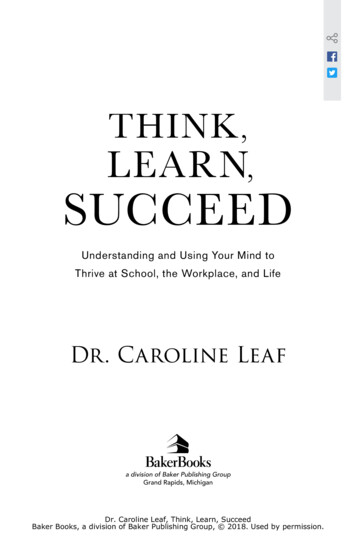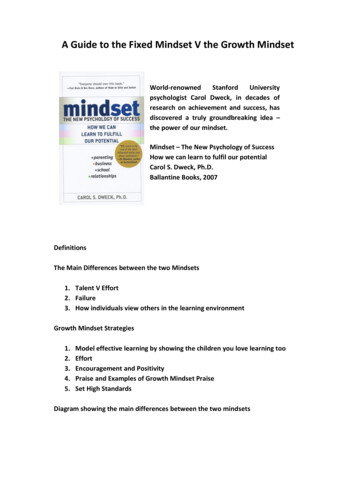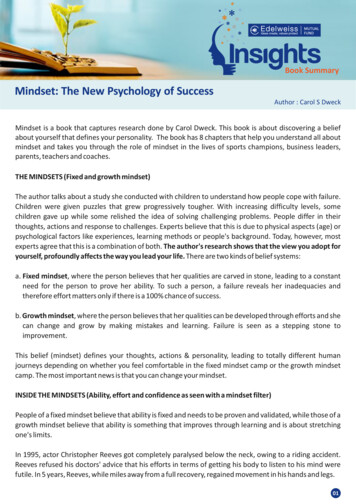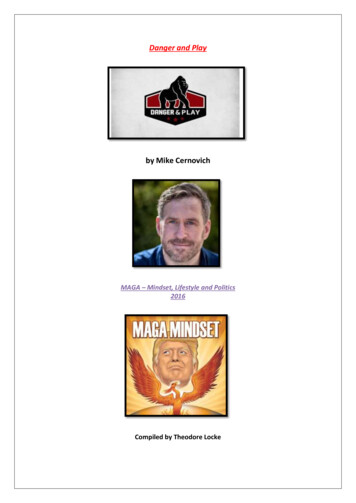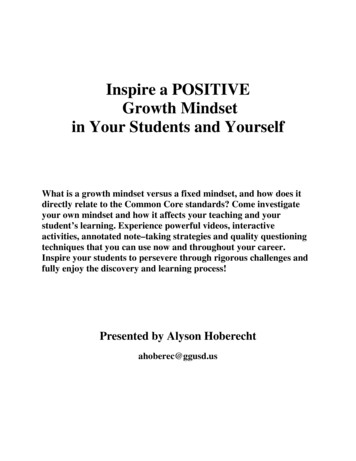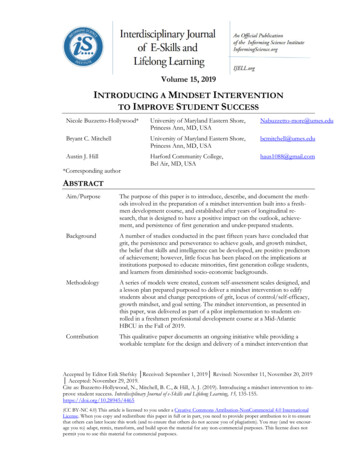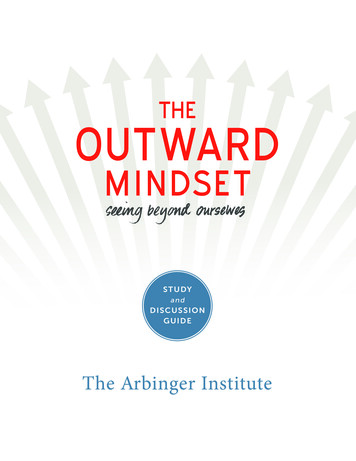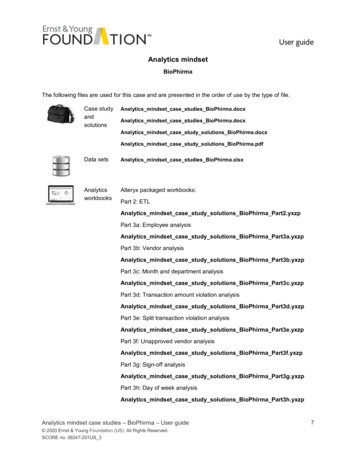
Transcription
Analytics mindsetBioPhirmaThe following files are used for this case and are presented in the order of use by the type of file.Case studyandsolutionsAnalytics mindset case studies BioPhirma.docxAnalytics mindset case studies BioPhirma.docxAnalytics mindset case study solutions BioPhirma.docxAnalytics mindset case study solutions BioPhirma.pdfData setsAnalytics mindset case studies BioPhirma.xlsxAnalyticsworkbooksAlteryx packaged workbooks:Part 2: ETLAnalytics mindset case study solutions BioPhirma Part2.yxzpPart 3a: Employee analysisAnalytics mindset case study solutions BioPhirma Part3a.yxzpPart 3b: Vendor analysisAnalytics mindset case study solutions BioPhirma Part3b.yxzpPart 3c: Month and department analysisAnalytics mindset case study solutions BioPhirma Part3c.yxzpPart 3d: Transaction amount violation analysisAnalytics mindset case study solutions BioPhirma Part3d.yxzpPart 3e: Split transaction violation analysisAnalytics mindset case study solutions BioPhirma Part3e.yxzpPart 3f: Unapproved vendor analysisAnalytics mindset case study solutions BioPhirma Part3f.yxzpPart 3g: Sign-off analysisAnalytics mindset case study solutions BioPhirma Part3g.yxzpPart 3h: Day of week analysisAnalytics mindset case study solutions BioPhirma Part3h.yxzpAnalytics mindset case studies – BioPhirma – User guide 2020 Ernst & Young Foundation (US). All Rights Reserved.SCORE no. 08247-201US 37
Part 3i: Key word analysisAnalytics mindset case study solutions BioPhirma Part3i.yxzpPart 3j: TF-IDF analysisAnalytics mindset case study solutions BioPhirma Part3j.yxzpVideosHow-to videos: Note that video links are removed for the external distribution of thisEYARC Access newsletter. See the user guide on the EYARC site to access the videolinks.Part 2: ETLAnalytics mindset case study solutions BioPhirma Part2Part 3: Apply appropriate data analytics techniquesAnalytics mindset case study solutions BioPhirma Part3aAnalytics mindset case study solutions BioPhirma Part3bAnalytics mindset case study solutions BioPhirma Part3cAnalytics mindset case study solutions BioPhirma Part3dAnalytics mindset case study solutions BioPhirma Part3eAnalytics mindset case study solutions BioPhirma Part3fAnalytics mindset case study solutions BioPhirma Part3gAnalytics mindset case study solutions BioPhirma Part3hAnalytics mindset case study solutions BioPhirma Part3iAnalytics mindset case study solutions BioPhirma Part3jOverviewThis case is designed for an accounting information systems, auditing, fraud or data analytics course. Thecase is designed to be flexible so that it can be implemented in class, used as homework, or as a studentproject or part of an exam.In this case, students are asked to assume the role of an advisor to BioPhirma, a global corporationbased in Atlanta, Georgia. BioPhirma is an innovative health care leader that conducts extensiveresearch and development activities to invent and test medications and treatments for a wide array ofhuman and animal medical conditions. Students are asked to advise BioPhirma on compliance with itspurchasing card (P-card) policies and to help investigate a whistle-blower tip about possible fraud beingcommitted through P-card transactions.A key feature of this case is that it walks students through the entire analytics mindset approach. Thestudents are able to practice developing their analytics mindset with rich, real-world data. As a reminder,an analytics mindset is the ability to: Ask the right questions Extract, transform and load relevant data (i.e., the ETL process)Analytics mindset case studies – BioPhirma – User guide 2020 Ernst & Young Foundation (US). All Rights Reserved.SCORE no. 08247-201US 32
Apply appropriate data analytics techniques Interpret and share results with stakeholdersThis is a four-part case. The following is a brief overview of each part.Part 1: In this part, students are given background about BioPhirma and its P-card transaction process.Students are also given insights into the current use of data and analytics in managing fraud risk. Anappendix is provided that provides BioPhirma’s P-card policies and also an overview of a specific textmining analytics technique, Term Frequency-Inverse Document Frequency (TF-IDF). Students are askedto think about the right questions they need to ask. This includes a focus on identifying risks related to theP-card transactions, controls that are (or are not) in place and the types of data analyses that could beconsidered to test these controls. Students are also asked to make a recommendation to BioPhirma’smanagement about additional controls or process changes that could be considered to address the riskrelated to its P-card transactions, even prior to performing any data analysis.Part 2: This part focuses on the ETL process. The data extraction process already has been completedfor the students. Students will receive one Excel data file with three tabs (Transactions, ApprovedVendors List and Authorized P-card Users) that includes all of the data needed. Students will be providedwith the details of each data field within the data set in the case background. Students are asked tocomplete select data validations to make certain that their data file is complete. Students are required toload their data correctly into the recommended tool, Alteryx. This loading, and any additional datatransformation needed for each analysis, will be shown in Part 3.Note: As the data file was not exceptionally large, we did not include a requirement for students to converteach tab in the Excel data file into a separate Alteryx database file (.yxmd file type) to use as the input filefor each workflow. Doing so typically provides more efficiency when a workflow is run. You can requirestudents to perform this step by creating a two-step workflow with the Input Data tool and selecting theExcel file and then using the Output Data tool with a file type of Alteryx Database, as shown below.Part 3: Students are asked to perform a series of analyses using Alteryx to provide insights into thecompliance with BioPhirma’s P-card policies and to identify any potential fraudulent transactions. Notethat you can ask students to perform all of these analyses, or selectively based on your learningobjectives. You can also require them to create an additional analysis of their own as this set of analysesis not comprehensive in addressing all possible risks and insights needed. In terms of complexity, Parts 3iand 3j are the most complex. There is a chart following that indicates the tools used in each Alteryxworkflow to provide you with an overview. Please be aware that there could be many approaches tocompleting each workflow. The following analyses are included:3a: Employee3b: VendorAnalytics mindset case studies – BioPhirma – User guide 2020 Ernst & Young Foundation (US). All Rights Reserved.SCORE no. 08247-201US 33
3c: Month and department3d: Transaction amount violation3e: Split transaction violation3f: Unapproved vendor3g: Sign-off3h: Day of week3i: Key word: Note that you can discuss with students the key words provided and whether there areadditional words they would like to add to the search and why these key words might be appropriate totarget. Support for this might be based on research of typical key words that forensic accountants mightseek to analyze based on the type of data source, or just based on their understanding of the companyand industry.3j: TF-IDF: Note that in the data cleansing for this analysis, Step 1.1, there is an option to removeunwanted characters with “Leading and Trailing Whitespace” selected. You might want to discuss withyour students the results that would be generated by selecting “Punctation,” as well. For example, if a Pcard holder enters a word in the description, but it is entered with various punctuation following it, such asa semicolon or a period, the analysis would identify each of these separately due to the punctuation,rather than as the same word. Alternatively, punctuation might be very significant, such as a hyphen usedin separating a series of numbers. This could be an example of when the students might initially performtheir analysis and then further refine their data cleansing based on what they see. It is important to notethat the selection of “Punctuation” in the data cleansing tool does not give an option to select specificpunctuation characters; therefore, it is all or nothing. If students are interested in removing selectpunctuation, they could consider adding a formula to cleanse the data, such as REPLACE where aspecific character is replaced with an empty string (“”).Part 4: Students are asked to interpret the results and make appropriate recommendations. Studentsshould be able to use their Alteryx workflows in a live setting to present their findings. Several of theanalyses require students to use the Reporting tool in Alteryx to generate interactive visualizations.Additionally, any other findings can be browsed and data within can be sorted or filtered, as needed.Alternatively, you can require students to produce output files from the workflows, including images, Excelfiles and more.Advanced preparationIt is recommended that you expose students to the definition and importance of the analytics mindset andrelated competencies prior to covering this case. The EYARC offers lecture notes, slides and acompetency framework in the Introduction to the analytics mindset module that you can use for thispurpose.DataThe data for this case is real-world P-card data that includes individual purchase transactions(approximately 82,000), approved vendors (approximately 10,600) and P-card users (approximately1,200). Select data has been cleansed for data privacy purposes.Analytics mindset case studies – BioPhirma – User guide 2020 Ernst & Young Foundation (US). All Rights Reserved.SCORE no. 08247-201US 34
Analytics toolsWe have designed this case to be flexible with respect to the tools that can be used to perform theanalyses. We provide the case and the solutions using Alteryx. This software is one of the leading selfservice data analytics programs currently available. It is a powerful tool for the ETL process and dataanalytics, and is especially known for its spatial analytics tools. “Alteryx allows a single user to accessvarious data sources, clean and prepare data, perform a variety of analyses and then deploy the resultsfor consumption and to operationalize the insights discovered. It boasts visual workflows and anintuitive drag-and-drop interface that can eliminate the need to write code.” 1The workflows allow the user to visually understand the steps that the data goes through fortransformation or analysis. This workflow also provides a clear audit trail and creates a repeatableprocess. When using an Alteryx workflow, the initial data sources remain intact. Alteryx performs thetransformation and generates a new output file, which helps maintain the integrity of the data, allowsmistakes to be easily fixed and allows the same workflow to be used on multiple data sets (with the samefields and properties). Alteryx can process very large data sets very quickly. As the workflow is running,the user can see where any errors may be occurring and can monitor the progress as percentage-ofcompletion statistics are calculated throughout. As soon as the data is processed, a report is generatedthat shows if there are any errors in any fields (e.g., trailing white spaces) that may create problems fordata analysis, as well as some basic visual analytics that show descriptive information about theprocessed data.Access: A free trial of Alteryx and academic licensing is available at d. Alteryx will provide individual licenses for students and faculty, as well as lablicenses for use in a computer lab or classroom. However, it is important to note that Alteryx only workson PCs at this time.Community and training: Alteryx is intuitive and easy to learn. It boasts an active user community(https://www.alteryx.com/community) that openly shares workflow examples to help users identifypotential solutions. Like other analytics tools, there are always many ways to organize data to achievethe desired solutions. By reviewing approaches of other data scientists, you and your students candevelop more advanced skills and perspectives. Also within the Alteryx community, there are easy-to-follow tutorials as part of the Alteryx cademy/ct-p/alteryx-academy). You can learn most of thenecessary ETL functions in a few hours using these tutorials. Further, there is a set of tutorials designed with the proficient Excel user in mind that walks youthrough basic Excel functions using Alteryx instead. As users become more advanced, they canparticipate in the Alteryx “weekly challenges” /bdp/weeklychallenge), which provide difficult data analytics problems for the user community to solve.Note that for Alteryx workflow solution files, these have been provided as a packaged workflow (.yxzp filetype [Options Export Workflow ]) that is a single, zipped file that includes the Alteryx workflow and all1“Alteryx, Inc. Form 10-K,” Securities and Exchange Commission website, 0119312518073878/d530988d10k.htm, accessed January 1, 2020.Analytics mindset case studies – BioPhirma – User guide 2020 Ernst & Young Foundation (US). All Rights Reserved.SCORE no. 08247-201US 35
of its dependencies (e.g., input file and naming convention for the output file). Students are asked tosubmit their completed packaged workflow as their deliverable using this file type as well, including theirname in the file, to allow the workflow to be easily executed. When this packaged workflow is opened,you will be asked to provide a file directory where you want the files to be saved before you are able torun the workflow.AnnotationOne of the nice features of this tool is that it allows the user to document each step of the workflowthrough the use of annotations. The case does not include requirements for students to annotate eachstep of their workflow as written, although annotations have been provided in the solution set. You canadd a requirement with a description of the level of detail that you would like to see, as desired.How-to videosHow-to videos have been prepared to accompany this case, with links listed on page two. These linkshave not been included in the case solutions file. These videos can help instructors learn the Alteryxworkflow steps and tools themselves and they can be provided directly to students to supplement in-classinstruction and facilitate their completion of the case.Alteryx workflow tool matrixSee the following page for an overview of the Alteryx tools used for each workflow in the case.Analytics mindset case studies – BioPhirma – User guide 2020 Ernst & Young Foundation (US). All Rights Reserved.SCORE no. 08247-201US 36
Alteryx ortingAnalysis2ETL3aEmployee3bVendor3cMonth y of week3iKey word3jTF-IDFAnalytics mindset case studies – BioPhirma – User guide 2020 Ernst & Young Foundation (US). All Rights Reserved.SCORE no. 08247-201US 37
Alteryx performs the transformation and generates a new output file, which helps maintain the integrity of the data, allows mistakes to be easily fixed and allows the same workflow to be used on multiple data sets (with the same fields and properties). Alteryx can process very
